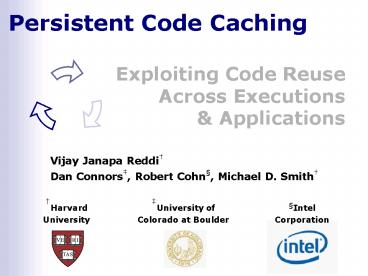Persistent Code Caching - PowerPoint PPT Presentation
Title:
Persistent Code Caching
Description:
Dan Connors , Robert Cohn , Michael D. Smith. Runtime Compilation ... File Roller. Gftp. Gqview. Normalized execution time. Runtime Compilation. Code Cache ... – PowerPoint PPT presentation
Number of Views:42
Avg rating:3.0/5.0
Title: Persistent Code Caching
1
Persistent Code Caching
Exploiting Code Reuse Across Executions
Applications
Vijay Janapa Reddi Dan Connors, Robert Cohn,
Michael D. Smith
Harvard University University of Colorado at Boulder Intel Corporation
2
Runtime Compilation System
- Execution environments
- that provide an interface
- to the dynamic instruction
- stream of an application
- Overheads
- Runtime compilation
- Performance of thecompiled code
3
Managing compilation overheadvia software code
caching
Original dynamic instruction stream
A
B
C
C
A
Reuse of cached code
Runtime Sys. (RS) Code caching
RS
A
B
RS
RS
C
C
A
Execution time
Basis 90 execution time in 10 (hot) code
4
Problem statement
- There exist execution domains where
- code caching is ineffective, which limits the
- deployment of runtime compilation systems
5
Caching performance variesbased on program
behavior
Loop intensive application
181.mcf
Runtime Compilation
Code Cache
176.gcc
Large code footprint infrequent code re-use
6
Caching performance variesbased on program
behavior
Loop intensive (frequent reuse)
Mcf
Eon
Vpr
Twolf
Gap
Bzip2
Runtime Compilation
Code Cache
Gzip
Parser
Vortex
Crafty
Perl
Large footprint (infrequent reuse)
Gcc
Normalized execution time
7
Benchmark 176.gcc is not an outlier
Oracle
Gedit
Dia
Runtime Compilation
Gvim
Code Cache
File Roller
GUI applications - Large startup cost -
Library initialization executed lt 10 times
Gftp
Gqview
Normalized execution time
8
Code caching suffers under certain execution
behaviors
- Less code reuse
- Large code footprint
- Short run times
Cold code is hot code across executions!!!
9
Caching code across executions improves caching
performance
Original dynamic instruction stream
A
B
C
C
A
Caching (Run 1)
Execution time
10
Implementation Framework Pin(Dynamic binary
instrumentation)
- Appropriate system for
- evaluating persistence
- General model
- Robust design
- Enterprise-scale usage
11
Persistent Pin
- Persistent Cache
- Translated code
- Translation data structures
- Correctness metadata
12
Experimental setup
Input X
- IA32 Linux implementation
- Bounded cache (320MB)
- Applications ran unmodified
- No cache flushes occurred
Persistent Cache X
Input ?
Measure improvement
13
Exploiting code reuse across executions and
applications
Code coverage Bull's eye (100 reuse)
14
Persistent caching works across program classes
Benefits large code footprint applications
SPEC 2000 INT (Reference inputs)
15
Persistent caching is effectivefor short-running
applications
Input data set alters program behavior
Small improvements gets bigger (Gap) and large
improvements get even larger (Gcc)
16
Evaluating persistent caching across program
inputs
253.perlbmk
175.vpr
176.gcc
164.gzip
256.bzip2
Oracle
90
100
50
60
70
80
Code coverage between inputs
17
Production environments require runtime systems
improvements
- Case study Regression testing of Oracle XE
- Oracle 80s
- Oracle
- Pin (translation) 2000s
- Oracle
- Pin (translation)
- Instrumentation (memory tracing) 3000s
One unit-test!
18
Oracle is a multi-process programming environment
Challenges
Oracles execution phases
Mount
Work
Start
Open
Close
19
Processes exhibitcode sharing
Oracles execution phases
Challenges
Mount
Work
Start
Open
Close
20
Every Oracle unit-test starts anew instance of
the database
Oracles execution phases
Challenges
Mount
Unit-test 1
Start
Open
Close
Mount
Unit-test 2
Start
Open
Close
21
Leveraging persistence across processes
22
Persistent Cache Accumulation (PCA) addresses
limited code coverage
Input X
Input Y
- Accumulate code across executions
Persistent Cache XY
Persistent Cache X
Input Z
Persistent Cache XY
Pin
Timed Run
23
Persistent Cache Accumulation (PCA) improves
unit-test performance
Accumulated persistent caches
24
Contributions Improved code caching
- Cold code is hot code!
- Persistence is effective
- Less code reuse
- Short run times
- Large code footprint
- Robust and performanceefficient implementation
- Production environment regression testing
study
25
Backup Slides
26
Future Research Questions
- Selective persistent caching
- Cache only cold/hot code
- Effectiveness of optimizations across
- Inputs
- Applications
- Impact of excessive cache accumulation
27
Persistent Cache SizesDS is larger than CC!
28
Persistent Cache SizesDS is larger than CC!
29
Cross-input Persistence reduces re-translation
across inputs
time
30 improvement via Cross-input Persistence
29
30
Persistent instrumentation issues
- Dynamically allocated memory
Called upon every instruction execution
VOID Analysis(COUNTER counter)
(counter) VOID
Instrumentation(INS ins, VOID v) STATS
stats new STATS( INS_Address(ins))
INS_InsertCall(ins, IPOINT_BEFORE, AFUNPTR
(Analysis), IARG_PTR, stats-gtcounter, )
VOID main(INT32 argc, CHAR
argv) INS_AddInstrumentFunc
tion(Instrumentation, 0)
PIN_StartProgram()
Called once per instruction compilation
Solution Allocate memory using the Persistent
Memory Allocator
31
Inter-Application exploits redundancy of library
translations
Application A
Application B
- Libraries (DSO)
- Initialization
- Toolkits/Pkgs
- X11
- GTK
- FLTK
Input X
Input Y
Persistent Cache X
Persistent Cache Y
Input X
Input Y
Timed Run
32
Inter-Application Persistence
33
Processes exhibitcode sharing
Oracles execution phases
Challenges
Mount
Work
Start
Open
Close































